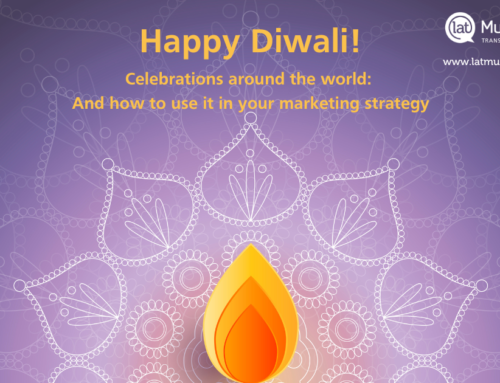First published on November 30, 2015 by Emily Larson
When developing a marketing strategy for your business you need a plan that will resonate with your audience and adapt to changes in the marketplace. To establish such a strategy, it’s likely that you’re combining tried-and-true practices with up-and-coming trends, both off and online. However, while you may be confident that certain established campaigns will get you results, when looking to the latest trends it can be difficult to know exactly where to start. It’s no secret that there’s a ton of jargon out there, but there are some strategies that are here to stay. In the digital world, the big ones include social media marketing, content marketing, and search engine optimization, but there’s one more that needs to be on your radar: cultural marketing. What is it and why should you care? Read our FAQs below to find out:
What is Cultural Marketing?
Cultural marketing is the practice of adapting your brand’s marketing strategy to different cultural groups by reaching out to them in their own language and on the platforms they are using. Rather than shouting at the top of your lungs hoping that the right person hears you, cultural marketing is about creating a specialized message targeted to specific demographics. Cultural marketing can be applied to traditional and digital campaigns and can encompass everything from the details of your written copy and visuals to SEO and your choice of social media platforms.
Rather than trying to lure your entire audience to one platform where you’ve established a presence, cultural marketing involves going to your online audiences on the platforms they’re already active on. It’s important to note that it is not a matter of establishing tons of small presences on a large smattering of platforms. Rather, cultural marketing works by researching your target demographics and understanding what platforms will give you the greatest engagement. Once you move beyond the English-speaking portion of the Internet (which is only 30% of the online population), you’ll quickly realize that there’s a lot more to social media marketing than a strong Facebook page. The best example of this phenomenon is China. Because of censorship, Facebook and Twitter aren’t particularly effective, but there are huge active user bases on Chinese platforms like Sina Weibo and WeChat. If you’re looking to move your business into China, wouldn’t it be helpful to know about these platforms while you’re developing your digital marketing strategy and not after you’re struggling to make an impression with your Facebook page? That’s what cultural marketing is all about.

How Does Cultural Marketing Work?
Cultural marketing works by creating specialized content for your audience on the specific platforms they are using. There are two key components to this process: research and local knowledge. Cultural marketing is only effective if you can reach your target audiences, so researching these audiences to figure out how and where they’re active is the initial step. Once you’ve established where your customers are, then you need someone with a local understanding of those communities who can create specialized content that will resonate with them.
Sometimes it is a matter of localizing content on platforms you’re already familiar with and likely active on. For example, if you’re bringing your brand to Quebec and want to set up a presence on social media, popular platforms like Facebook, Twitter, and Instagram are still going to serve you well. However, you would not have much success with an English-language presence; instead, you would need to push out French language content that is localized for Quebecois culture. Learn more about how this process can work in Quebec here. Sometimes it is also a matter of localizing content for an entirely new platform, such as when trying to reach Chinese audiences as discussed above. Either way, cultural marketing works by using in-depth local knowledge to reach out and engage your target markets in the language they use and on the platforms they love.
Why Does Cultural Marketing Matter?
Cultural marketing can sound like a lot of work. And that’s probably because it is. However, businesses shy away from this effective strategy at their own expense. Yes, it is an investment, but when 70% of the Internet population speaks a language other than English, it is certainly worthwhile. China boasts over 700 million active Internet users, and there are highly engaged followers on platforms like Weibo and WeChat. Consider this: WeChat currently has over 650 million users, 200 million of which have registered their credit card with the app for mobile e-commerce
Even if you’re not looking overseas, chances are your local markets are more multilingual than you’d expect. Canada’s metropolitan centres are quickly becoming multicultural hubs. It is projected that by 2031, 78% of Toronto’s population and 70% of Vancouver’s population will be foreign-born or children of immigrant parents[2]. Similarly, there are already 52.6 million Spanish speakers in the United States. Not convinced yet? By 2050, with an estimated 132.8 million speakers, the United States is on track to become have the world’s largest Spanish-speaking country [3]. You’d run a Spanish language campaign in Spain or Mexico, so why not apply the same logic to the American market?

Why is a Translation Company Offering this Service?
First off, LAT Multilingual is a translation and marketing company, but it wasn’t always that way. As our CEO explains, evolutions in the translation industry have made it clear that translators with a strong understanding of digital marketing strategies are well-positioned to better serve their clients’ needs. Whereas we previously translated product labels and internal communications, we now also work with social media copy and SEO plans. The worlds of marketing and translation have always been close; translating any kind of marketing copy requires an understanding not only of language, but of the target market. As digitization and globalization continue to rise, bringing translation and marketing together is essential.
Cultural marketing requires an intricate understanding of local markets, including language. Translators have this nuanced knowledge and understand how to leverage it for your brand’s marketing campaigns.
How Do I Get Started?
Unless you already have access to a thorough understanding of the language and culture of your target demographics, ask for help! LAT Multilingual specializes in cultural marketing and would be happy to discuss your need with you. Contact us today for more information on how you can reach new audiences.
[1] https://techcrunch.com/2015/11/10/tencents-wechat-messaging-app-reaches-200m-users-on-its-payments-service/[2] Statistics Canada – Allophone population, selected census metropolitan areas, 2006, https://www.bcstats.gov.bc.ca/StatisticsBySubject/Demography/PopulationProjections.aspx[3] Instituto Cervantes, “El español: una lengua viva, Informe 2015”













